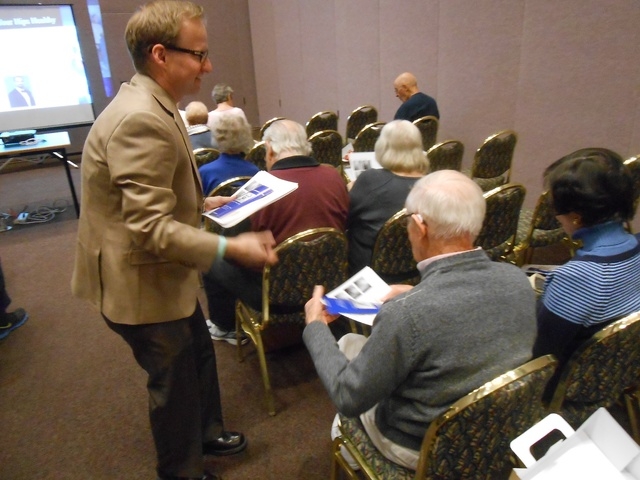Valley Health System seminar gives seniors healthy hip tips
The Valley Health System hosted a presentation Jan. 9 at Sun City Summerlin on the topic “How to Keep Your Hips Healthy.” Gerry Lethbridge was there because she was having issues with her right hip after she fell six months ago and broke her arm.
“My right knee buckled,” she said. “I’m afraid next time it could be my hip.”
Dr. Parminder Kang, an orthopedic surgeon, performs most of his surgeries at Centennial Hills Hospital Medical Center, 6900 N. Durango Drive. He said most hip issues begin with pain and swelling.
Often, the culprit is the wearing away of cartilage, Kang said. Since the body can’t rebuild cartilage, it addresses the loss by forming new bone instead.
“You’ll notice it’s harder to tie your shoes, to bend over to pick things up,” he told the audience of about 50 in the Desert Vista Community Center, 10360 Sun City Blvd.
Lethbridge said she wanted to learn how to make her joints stronger so she could avoid future injuries. Another resident, Nilda Kunich, was experiencing pain in her left hip area. Her right hip was replaced five years ago.
“I want to know if there’s something new now because I’ll probably have to have this one replaced,” she said, adding that it was nice that the community hosted the event “so I don’t have to drive too far. It’s very convenient.”
Arthritis is another factor in joint replacements. Based on 2007-09 data from the National Health Interview Survey, an estimated 50 million (22 percent) of adults in the U.S. have self-reported, doctor-diagnosed arthritis, with 21 million (9 percent of all adults) reporting activity limitation. By 2030, an estimated 37 percent (25 million adults) of those with arthritis will report arthritis-attributable activity limitations, according to study predictions.
Knee issues can present as hip problems, so X-rays and sometimes MRIs are used to determine the exact problem.
Implants have gotten smaller and are better, Kang said. But the femur is a hollow bone that still needs to be prepared to accept the implant, and the area is a tight one to work in, so there will always be a scar.
The good news on that front: Incisions that used to be up to 8 inches long are now usually a third of that.
For surgery, it’s now common to give nerve blocks and general anesthesia, so people wake up with no pain. Physical therapy begins the next day. Kang said most people are walking without a walker by six weeks. It used to be 12 weeks.
What are the biggest developments for hip replacements?
“The minimally invasive hip and the advancements in anesthesia, so really, two things,” Kang said. “So, pain is much less, recovery is much faster … compared to 10 years ago. Back 10 or 15 years ago, people would be in the hospital for a week. Now, we have them two days in the hospital.”
He said that was due in part to using a combination of drugs to manage pain.
“Before we used to target just one drug; now, more and more, we use four or five different drugs — an anti-inflammatory, IV Tylenol, pain medication, nerve blocks — so a lot of it hasn’t been (because of) the orthopedic surgeon, it’s the team around us. And the surgeries have gotten smaller; smaller incisions mean less pain. The implant development? Actually, 10 years ago was a big jump, and the implants last longer.”
Hip replacement parts can be metal such as cobalt chrome or plastic with ceramic liners.
The doctor suggested the surgery would eventually become an outpatient one — where the patient is discharged the same day — as more advancements occur.
“We tend to want to do things we did when we were younger,” Kang said. “And we want to keep doing that, so what I see in clinic is people saying, ‘Doc, I don’t think modifying my activities is a good option.’ But it is. If playing golf hurts, then maybe cutting back on that would help an arthritic hip. Biking and treadmill (workouts) are also very good for joints to keep them active, keep the strength there and create natural lubrication. And then, weight control, so a heavier person is going to have more problems with their hip.”
As for what people could do on their own, Kang said taking glucosamine chondroitin could help arthritis symptoms but only so much and that seniors who included stretching in their daily routines could mitigate the chance of bursitis, which often accompanies hip issues.
The Valley Health System hosts such talks, which are free, regularly, though most are held at its hospitals. For more information, visit valleyhealthsystemlv.com.
Contact Summerlin/Summerlin South View reporter Jan Hogan at jhogan@viewnews.com or 702-387-2949.




























